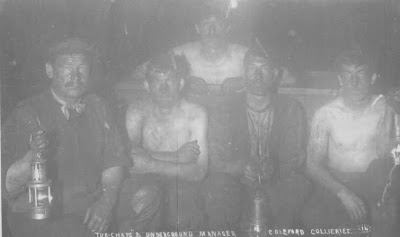
The Mackintosh Colliery where both Will Jones and his father worked. It was opened in 1867 and closed in 1919 because of flooding. The shaft was 1,620 feet deep, one of the deepest in the North Somerset coalfield.

The Newbury pit yard. In the foreground is the timber shed where John Marchant Jones worked as a sawyer.
 The forge at Newbury. The man in the left foreground with the axe is John Marchant Jones.
The forge at Newbury. The man in the left foreground with the axe is John Marchant Jones.Will Jones went down the Newbury pit in the early 1900's to take the following pictures of life at the coalface. It should be remembered that he was using a primitive box camera which employed glass plates, not film. The flash bulb was not invented for another thirty years, and so he would have used explosive flash powder, ignited on a metal plate as he opened the shutter.


 Notice in the above picture that the man on the left is wearing the notorious guss and crook, a harness which passed under his crutch to draw a "putt", a sledge laden with coal.
Notice in the above picture that the man on the left is wearing the notorious guss and crook, a harness which passed under his crutch to draw a "putt", a sledge laden with coal.


When it was decided to build a new chimney at Mackintosh, much higher than the old, on completion Will Jones climbed it with his camera on his back to take photographs from the top. He used the iron rung ladder set into the chimney and, when he reached the top, set up his equipment on a few planks of wood. He was assisted by a Mr Bellis, the steeplejack who had supervised the building of the chimney. Perched a hundred feet above the ground, because of the wind Bellis had to hold steady the cloth which covered Will and his camera as he exposed the plates. A photograph survives of the men on the chimney scaffolding but not the photographs taken from the top.
Will, however, performed the feat again when a new chimney was built at Newbury.

Will Jones on the Newbury chimney. The following two views of the pit yard were taken from there.

 Sadly Will Jones was no sentimentalist. When he acquired the Newbury pit yard after the Second World War for his concrete block business, he wiped all his priceless glass negative plates and used them to repair the windows in the buildings!
Sadly Will Jones was no sentimentalist. When he acquired the Newbury pit yard after the Second World War for his concrete block business, he wiped all his priceless glass negative plates and used them to repair the windows in the buildings! 